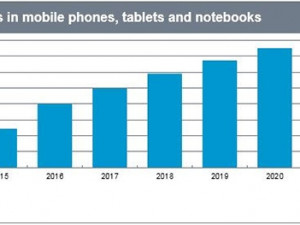
Following the information company's commentary on market expectations for access control in 2017, the latest IHS Markit Microelectromechanical Systems and Sensors Intelligence Service report has found that fingerprint sensors will reach nearly one billion in 2017.
It has noted that fingerprint sensors are experiencing explosive growth and can be expected to be the standard feature for most mid-end and high-end smartphones from 2017 onwards. With smartphones driving the market so far, growth from the year onwards is said to rely more on how much low-end smartphones, notebooks and tablets are used.
Mid-end and high-end smartphones have been driving the market so far. However, the company believes growth from 2017 and 2018 onwards will also rely more on the usage of low-end smart phones, notebooks and tablets. According to the company, the period of fastest growth was 2015 and 2016, with more than 60% growth each year in sensor unit shipments. Annual growth from 2016 to 2020 is forecast in the range of 10 to 25% each year as the mid- and high-end smart phones markets saturate.
IHS Markit estimates 797 million sensors are estimated to have been shipped in 2016, with the majority (89%) in smartphones as well as some in tablets and notebooks. In 2017, the market is forecast to grow to 990 million units. While other biometrics are said to be slowly entering the market, the company says they seem to rather work to complement than replace fingerprint solutions.
Apple has the most estimated sensor shipments with up 29%, with Samsung smartphones at 21% and the remainder for Chinese phone manufacturers like Huawei, Oppo and Xiaomi.
"A key market trend is the expected move to under-glass sensors. This provides an opportunity for optical and ultrasonic sensors in the market, as capacitive sensors can only pass a signal through 300 microns of glass compared to 800 or 1 000 for a typical display thickness. However, capacitive sensors dominated the market with a 99% share in 2016."
Fingerprint sensors are primarily used for device login and can also be used for payment security. Mobile phone use for making payments has greatly increased in China in the past two years. Swipe sensors have exited the market (less than 1% in 2016), with touch sensors now accounting for 99% of the market," says IHS Markit principal analyst Jamie Fox.

Share